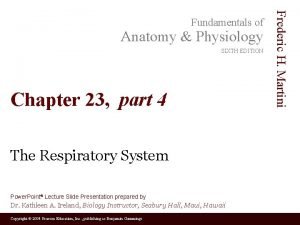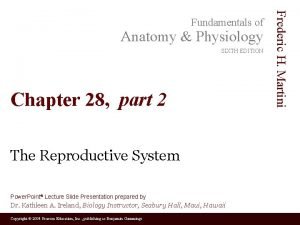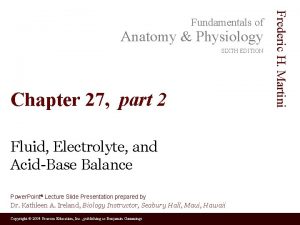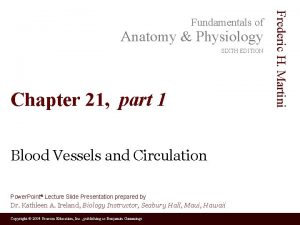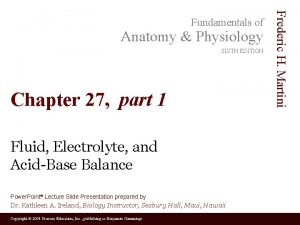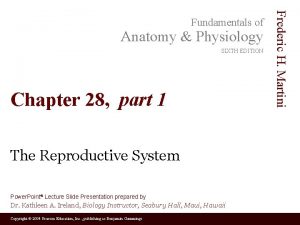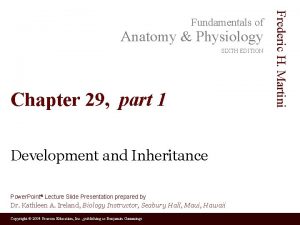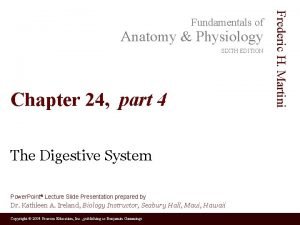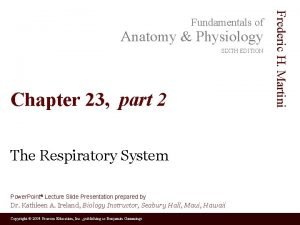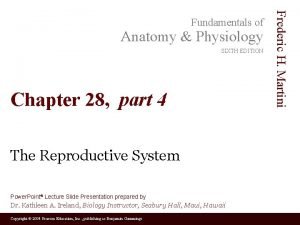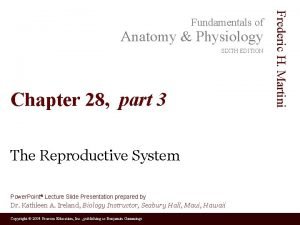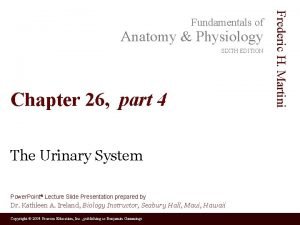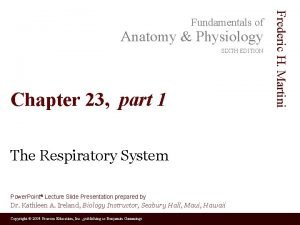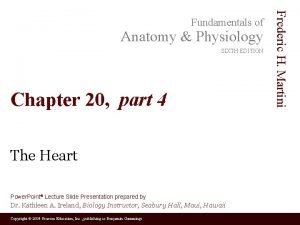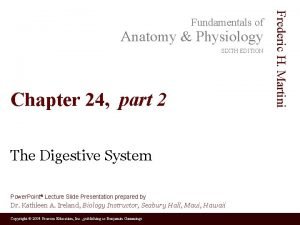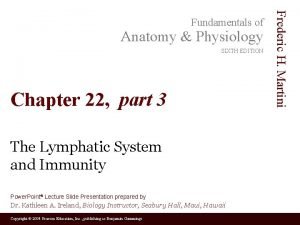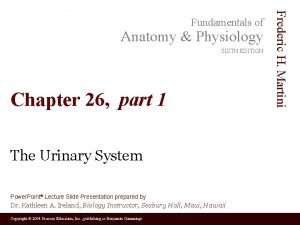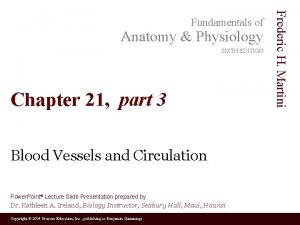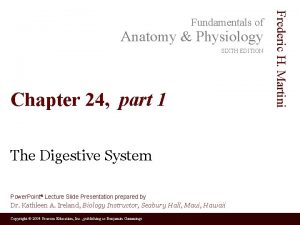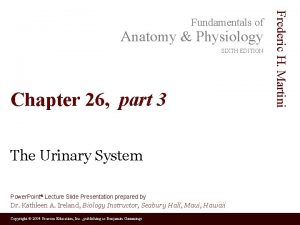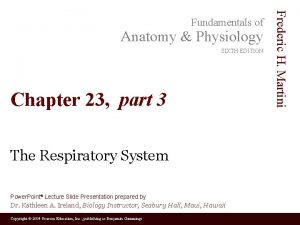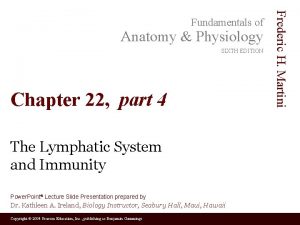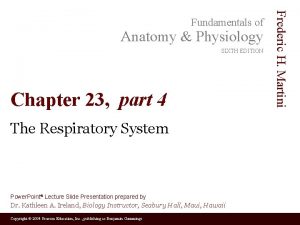Anatomy Physiology SIXTH EDITION Chapter 21 part 2
























- Slides: 24

Anatomy & Physiology SIXTH EDITION Chapter 21, part 2 Blood Vessels and Circulation Power. Point® Lecture Slide Presentation prepared by Dr. Kathleen A. Ireland, Biology Instructor, Seabury Hall, Maui, Hawaii Copyright © 2004 Pearson Education, Inc. , publishing as Benjamin Cummings Frederic H. Martini Fundamentals of

Arterial blood pressure • Maintains blood flow through capillary beds • Rises during ventricular systole and falls during ventricular diastole • Pulse is a rhythmic pressure oscillation that accompanies each heartbeat • Pulse pressure = difference between systolic and diastolic pressures Mean arterial pressure (MAP) Copyright © 2004 Pearson Education, Inc. , publishing as Benjamin Cummings

Figure 21. 10 Pressures within the Cardiovascular System Copyright © 2004 Pearson Education, Inc. , publishing as Benjamin Cummings Figure 21. 10

Figure 21. 10 Pressures within the Cardiovascular System Copyright © 2004 Pearson Education, Inc. , publishing as Benjamin Cummings Figure 21. 10

Capillary Exchange • Flow of water and solutes from capillaries to interstitial space • Plasma and interstitial fluid are in constant communication • Assists in the transport of lipids and tissue proteins • Accelerates the distribution of nutrients • Carries toxins and other chemical stimuli to lymphoid tissues Copyright © 2004 Pearson Education, Inc. , publishing as Benjamin Cummings

Processes that move fluids across capillary walls • Diffusion • Filtration • Hydrostatic pressure (CHP) • Reabsorption Copyright © 2004 Pearson Education, Inc. , publishing as Benjamin Cummings

Figure 21. 12 Capillary Filtration Copyright © 2004 Pearson Education, Inc. , publishing as Benjamin Cummings Figure 21. 12

Figure 21. 12 Capillary Filtration Copyright © 2004 Pearson Education, Inc. , publishing as Benjamin Cummings Figure 21. 12

Forces acting across capillary walls • Capillary hydrostatic pressure (CHP) • Blood colloid osmotic pressure (BCOP) • Interstitial fluid colloid osmotic pressure (ICOP) • Interstitial fluid hydrostatic pressure (IHP) Copyright © 2004 Pearson Education, Inc. , publishing as Benjamin Cummings

Filtration and reabsorption • Processes involved in filtration and reabsorption include • Net hydrostatic pressure • CHP - IHP • Net colloid osmotic pressure • BCOP - ICOP Copyright © 2004 Pearson Education, Inc. , publishing as Benjamin Cummings

Figure 21. 13 Forces Acting across Capillary Walls Copyright © 2004 Pearson Education, Inc. , publishing as Benjamin Cummings Figure 21. 13

Venous pressure and venous return • Assisted by two processes • Muscular compression • The respiratory pump PLAY Animation: Factors that Affect Blood Pressure Copyright © 2004 Pearson Education, Inc. , publishing as Benjamin Cummings

SECTION 21 -3 Cardiovascular Regulation Copyright © 2004 Pearson Education, Inc. , publishing as Benjamin Cummings

Cardiovascular Regulation • Autoregulation • Neural mechanisms • Endocrine mechanisms Copyright © 2004 Pearson Education, Inc. , publishing as Benjamin Cummings

Autoregulation of blood flow within tissues • Local vasodilators accelerate blood flow in response to: • Decreased tissue O 2 levels or increased CO 2 levels • Generation of lactic acid • Release of nitric acid • Rising K+ or H+ concentrations in interstitial fluid • Local inflammation • Elevated temperature Copyright © 2004 Pearson Education, Inc. , publishing as Benjamin Cummings

Figure 21. 14 Homeostatic Adjustments that Compensate for a Reduction in Blood Pressure and Blood Flow Copyright © 2004 Pearson Education, Inc. , publishing as Benjamin Cummings Figure 21. 14

Figure 21. 14 Homeostatic Adjustments that Compensate for a Reduction in Blood Pressure and Blood Flow Copyright © 2004 Pearson Education, Inc. , publishing as Benjamin Cummings Figure 21. 14

Neural Mechanisms • Adjust CO and PR to maintain vital organ blood flow • Medullary centers of regulatory activity include • Cardiac centers • Vasomotor centers control • Vasoconstriction via adrenergic release of NE • Vasodilation via direct or indirect release of NO Copyright © 2004 Pearson Education, Inc. , publishing as Benjamin Cummings

Reflex control of cardiovascular function • Baroreceptors reflexes monitor stretch • Atrial baroreceptors monitor blood pressure • Chemoreceptor reflexes monitor CO 2, or p. H levels PLAY Animation: Autoregulation and Capillary Dynamics Copyright © 2004 Pearson Education, Inc. , publishing as Benjamin Cummings

Figure 21. 15 Baroreceptor Reflexes of the Carotid and Aortic Sinuses Copyright © 2004 Pearson Education, Inc. , publishing as Benjamin Cummings Figure 21. 15

Figure 21. 16 The Chemoreceptor Reflexes Copyright © 2004 Pearson Education, Inc. , publishing as Benjamin Cummings Figure 21. 16

Hormones and cardiovascular regulation • Antidiuretic hormone – released in response to decreased blood volume • Angiotensin II – released in response to a fall in blood pressure • Erythropoietin – released if BP falls or O 2 levels are abnormally low • Natriuretic peptides – released in response to excessive right atrial stretch Copyright © 2004 Pearson Education, Inc. , publishing as Benjamin Cummings

Figure 21. 17 The Regulation of Blood Pressure and Blood Volume Copyright © 2004 Pearson Education, Inc. , publishing as Benjamin Cummings Figure 21. 17 a

Figure 21. 17 The Regulation of Blood Pressure and Blood Volume Copyright © 2004 Pearson Education, Inc. , publishing as Benjamin Cummings Figure 21. 17 b
 3 layers of muscle
3 layers of muscle Human anatomy & physiology edition 9
Human anatomy & physiology edition 9 Uterus perimetrium
Uterus perimetrium Inicum
Inicum The sixth sick sheik's sixth sheep's sick lyrics
The sixth sick sheik's sixth sheep's sick lyrics The central sulcus divides which two lobes? (figure 14-13)
The central sulcus divides which two lobes? (figure 14-13) Chapter 1 introduction to human anatomy and physiology
Chapter 1 introduction to human anatomy and physiology Anatomy and physiology chapter 8 special senses
Anatomy and physiology chapter 8 special senses Chapter 13 anatomy and physiology of pregnancy
Chapter 13 anatomy and physiology of pregnancy Anatomy and physiology chapter 2
Anatomy and physiology chapter 2 Chapter 7:9 lymphatic system
Chapter 7:9 lymphatic system Chapter 14 the digestive system and body metabolism
Chapter 14 the digestive system and body metabolism Chapter 10 blood anatomy and physiology
Chapter 10 blood anatomy and physiology Anatomy and physiology chapter 15
Anatomy and physiology chapter 15 Necessary life functions anatomy and physiology
Necessary life functions anatomy and physiology Holes anatomy and physiology chapter 1
Holes anatomy and physiology chapter 1 Gi tract histology
Gi tract histology Chapter 1 introduction to human anatomy and physiology
Chapter 1 introduction to human anatomy and physiology Chapter 2 human reproductive anatomy and physiology
Chapter 2 human reproductive anatomy and physiology Anterior surface of scapula
Anterior surface of scapula Chapter 6 general anatomy and physiology
Chapter 6 general anatomy and physiology Anterior posterior ventral dorsal
Anterior posterior ventral dorsal Biochemistry sixth edition 2007 w.h. freeman and company
Biochemistry sixth edition 2007 w.h. freeman and company Computer architecture a quantitative approach sixth edition
Computer architecture a quantitative approach sixth edition Automotive technology principles diagnosis and service
Automotive technology principles diagnosis and service

























